2019 Lexus LC500h ESP
[x] Cancel search: ESPPage 228 of 432
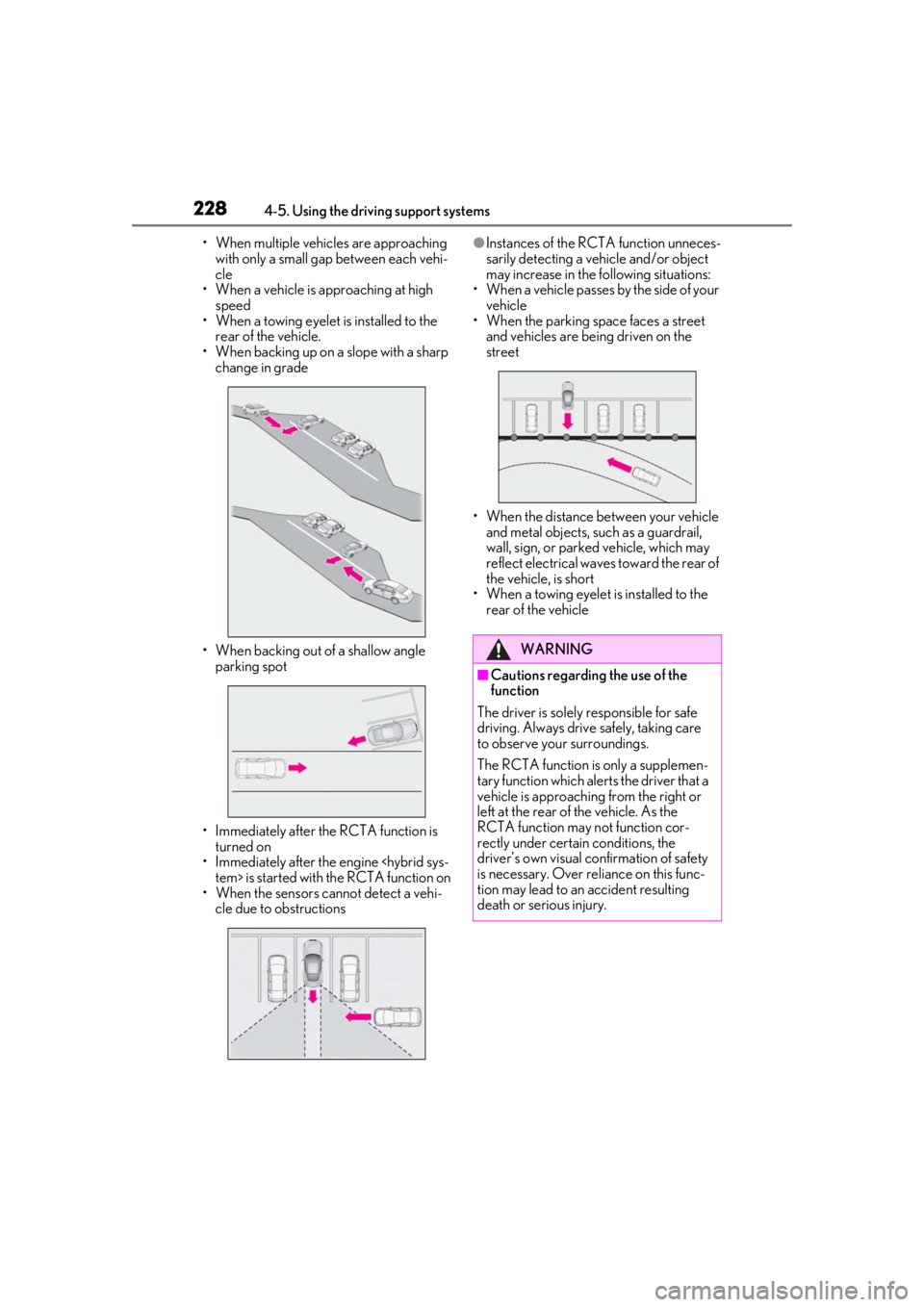
2284-5. Using the driving support systems
• When multiple vehicles are approaching with only a small gap between each vehi-
cle
• When a vehicle is approaching at high speed
• When a towing eyelet is installed to the
rear of the vehicle.
• When backing up on a slope with a sharp change in grade
• When backing out of a shallow angle parking spot
• Immediately after the RCTA function is turned on
• Immediately after the engine
• When the sensors cannot detect a vehi- cle due to obstructions●Instances of the RCTA function unneces-
sarily detecting a vehicle and/or object
may increase in the following situations:
• When a vehicle passes by the side of your vehicle
• When the parking space faces a street
and vehicles are being driven on the
street
• When the distance between your vehicle and metal objects, such as a guardrail,
wall, sign, or parked vehicle, which may
reflect electrical waves toward the rear of
the vehicle, is short
• When a towing eyelet is installed to the
rear of the vehicle
WARNING
■Cautions regarding the use of the
function
The driver is solely responsible for safe
driving. Always drive safely, taking care
to observe your surroundings.
The RCTA function is only a supplemen-
tary function which alerts the driver that a
vehicle is approaching from the right or
left at the rear of the vehicle. As the
RCTA function may not function cor-
rectly under certai n conditions, the
driver’s own visual confirmation of safety
is necessary. Over re liance on this func-
tion may lead to an accident resulting
death or serious injury.
Page 229 of 432
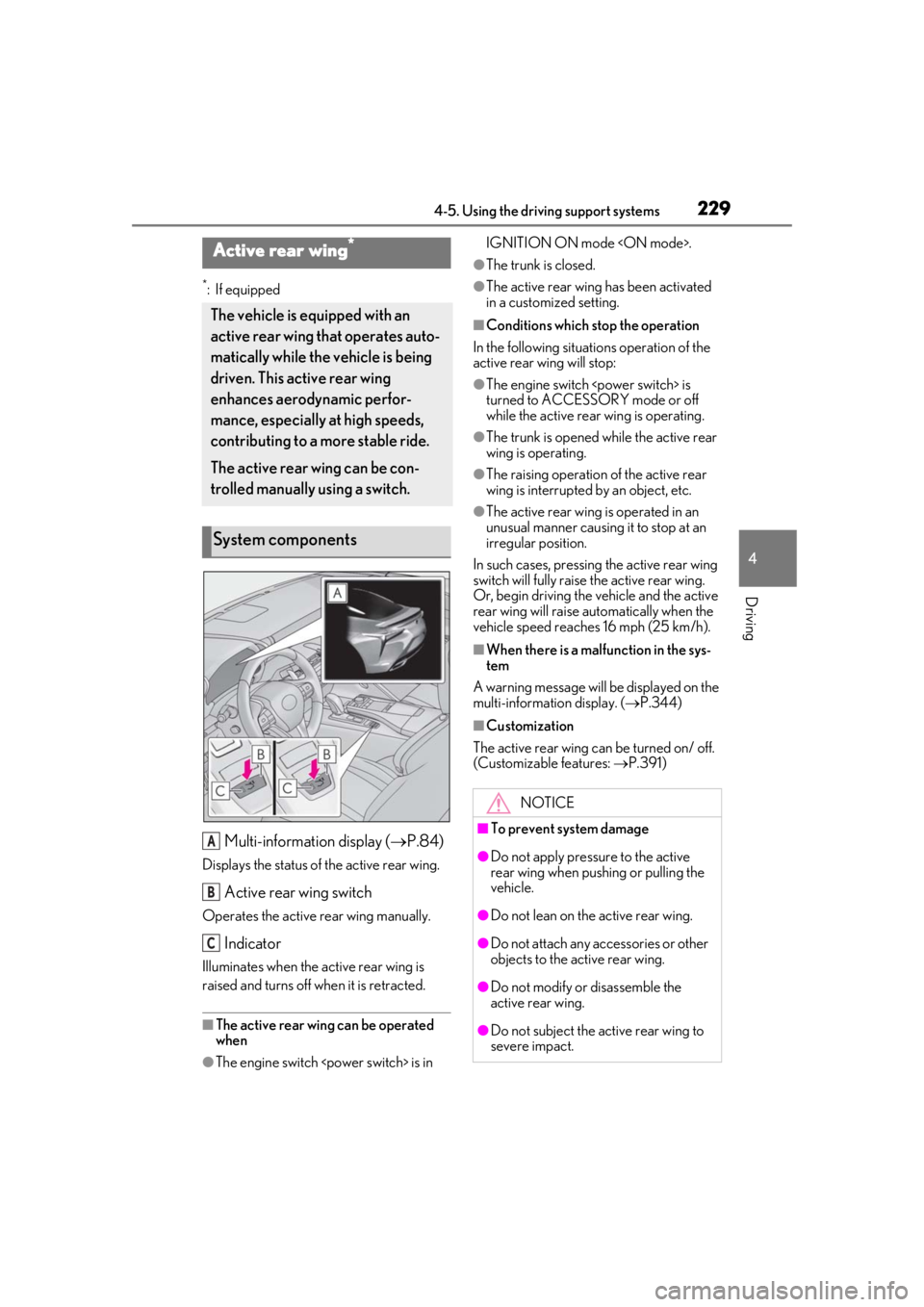
2294-5. Using the driving support systems
4
Driving
*:If equipped
Multi-information display (P.84)
Displays the status of the active rear wing.
Active rear wing switch
Operates the active rear wing manually.
Indicator
Illuminates when the active rear wing is
raised and turns off when it is retracted.
■The active rear wing can be operated
when
●The engine switch
●The trunk is closed.
●The active rear wing has been activated
in a customized setting.
■Conditions which stop the operation
In the following situat ions operation of the
active rear wing will stop:
●The engine switch
turned to ACCESSORY mode or off
while the active rear wing is operating.
●The trunk is opened while the active rear
wing is operating.
●The raising operation of the active rear
wing is interrupted by an object, etc.
●The active rear wing is operated in an
unusual manner causing it to stop at an
irregular position.
In such cases, pressing the active rear wing
switch will fully raise the active rear wing.
Or, begin driving the vehicle and the active
rear wing will raise automatically when the
vehicle speed reaches 16 mph (25 km/h).
■When there is a malfunction in the sys-
tem
A warning message will be displayed on the
multi-information display. ( P.344)
■Customization
The active rear wing can be turned on/ off.
(Customizable features: P.391)
Active rear wing*
The vehicle is equipped with an
active rear wing that operates auto-
matically while the vehicle is being
driven. This active rear wing
enhances aerodynamic perfor-
mance, especially at high speeds,
contributing to a more stable ride.
The active rear wing can be con-
trolled manually using a switch.
System components
A
B
C
NOTICE
■To prevent system damage
●Do not apply pressure to the active
rear wing when pushing or pulling the
vehicle.
●Do not lean on the active rear wing.
●Do not attach any accessories or other
objects to the active rear wing.
●Do not modify or disassemble the
active rear wing.
●Do not subject the active rear wing to
severe impact.
Page 230 of 432
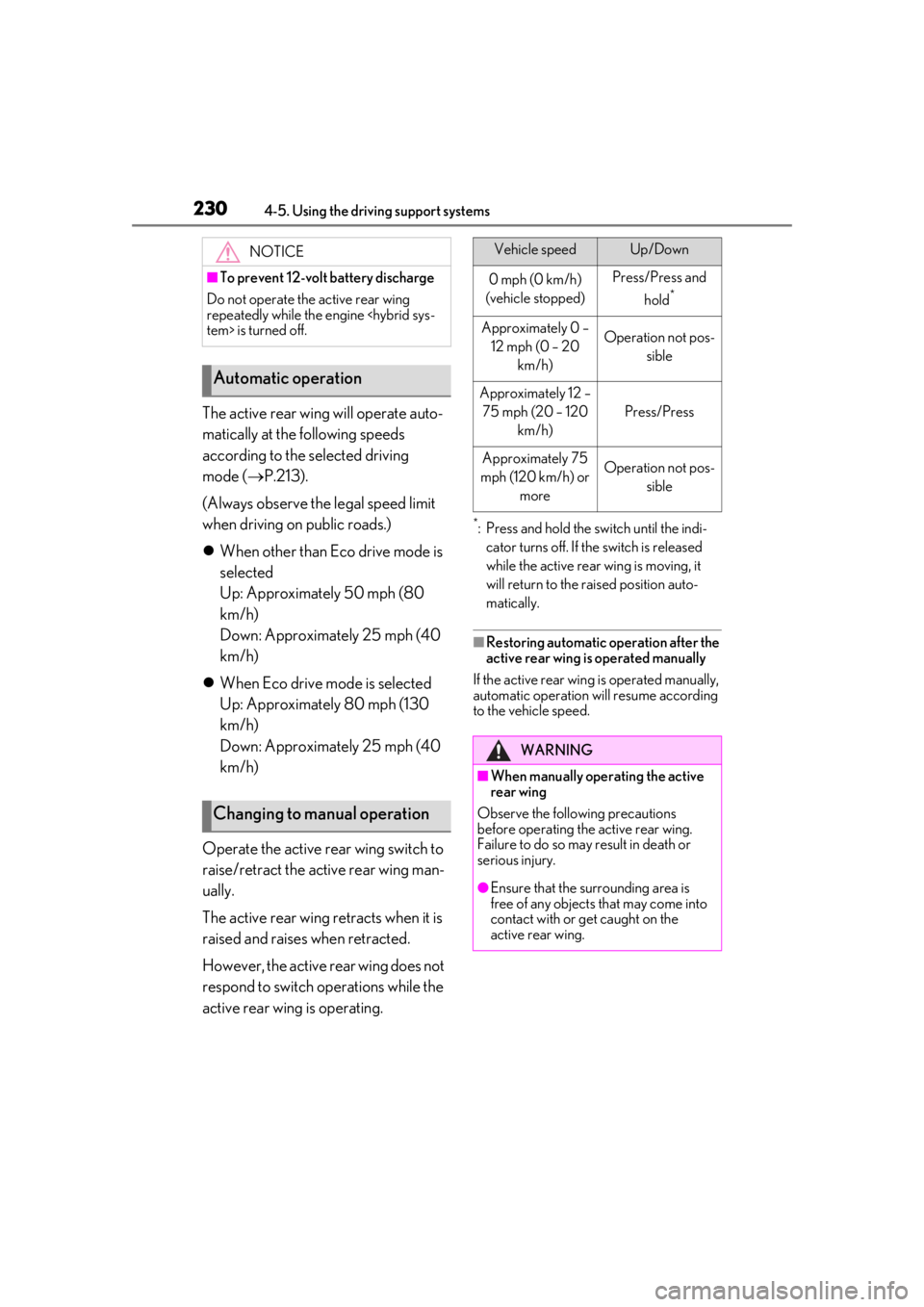
2304-5. Using the driving support systems
The active rear wing will operate auto-
matically at the following speeds
according to the selected driving
mode (P.213).
(Always observe the legal speed limit
when driving on public roads.)
When other than Eco drive mode is
selected
Up: Approximately 50 mph (80
km/h)
Down: Approximately 25 mph (40
km/h)
When Eco drive mode is selected
Up: Approximately 80 mph (130
km/h)
Down: Approximately 25 mph (40
km/h)
Operate the active rear wing switch to
raise/retract the active rear wing man-
ually.
The active rear wing retracts when it is
raised and raises when retracted.
However, the active rear wing does not
respond to switch operations while the
active rear wing is operating.
*: Press and hold the sw itch until the indi-
cator turns off. If the switch is released
while the active rear wing is moving, it
will return to the raised position auto-
matically.
■Restoring automatic operation after the
active rear wing is operated manually
If the active rear wing is operated manually,
automatic operation will resume according
to the vehicle speed.
NOTICE
■To prevent 12-volt battery discharge
Do not operate the active rear wing
repeatedly while the engine
Automatic operation
Changing to manual operation
Vehicle speedUp/Down
0 mph (0 km/h)
(vehicle stopped)Press/Press and
hold
*
Approximately 0 – 12 mph (0 – 20 km/h)Operation not pos- sible
Approximately 12 – 75 mph (20 – 120 km/h)
Press/Press
Approximately 75
mph (120 km/h) or moreOperation not pos- sible
WARNING
■When manually operating the active
rear wing
Observe the following precautions
before operating the active rear wing.
Failure to do so may result in death or
serious injury.
●Ensure that the surrounding area is
free of any objects that may come into
contact with or get caught on the
active rear wing.
Page 231 of 432
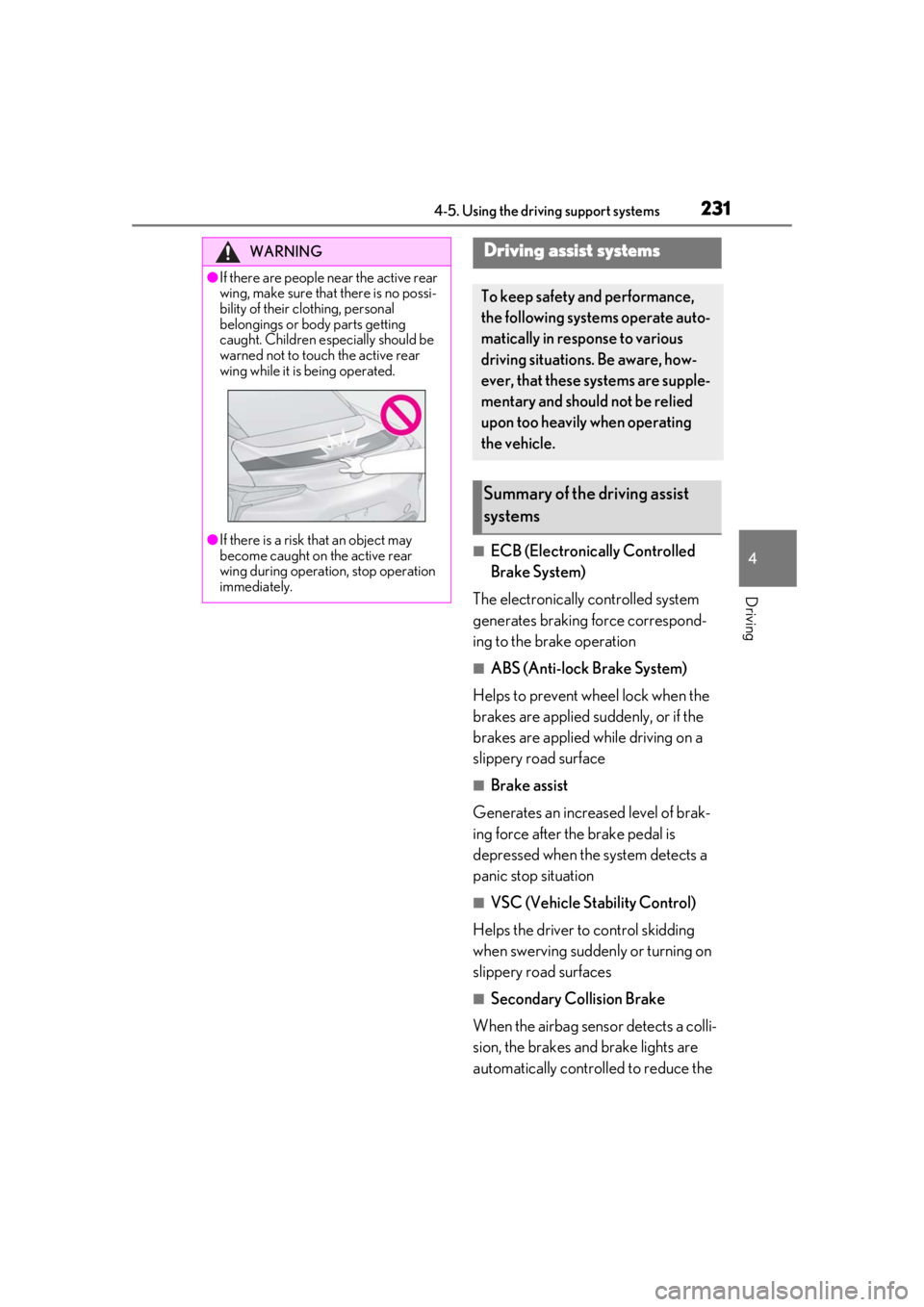
2314-5. Using the driving support systems
4
Driving
■ECB (Electronically Controlled
Brake System)
The electronically controlled system
generates braking force correspond-
ing to the brake operation
■ABS (Anti-lock Brake System)
Helps to prevent wheel lock when the
brakes are applied suddenly, or if the
brakes are applied while driving on a
slippery road surface
■Brake assist
Generates an increased level of brak-
ing force after the brake pedal is
depressed when the system detects a
panic stop situation
■VSC (Vehicle Stability Control)
Helps the driver to control skidding
when swerving sudden ly or turning on
slippery road surfaces
■Secondary Collision Brake
When the airbag sensor detects a colli-
sion, the brakes and brake lights are
automatically controlled to reduce the
WARNING
●If there are people near the active rear
wing, make sure that there is no possi-
bility of their clothing, personal
belongings or body parts getting
caught. Children especially should be
warned not to touch the active rear
wing while it is being operated.
●If there is a risk that an object may
become caught on the active rear
wing during operation, stop operation
immediately.
Driving assist systems
To keep safety and performance,
the following systems operate auto-
matically in response to various
driving situations. Be aware, how-
ever, that these systems are supple-
mentary and should not be relied
upon too heavily when operating
the vehicle.
Summary of the driving assist
systems
Page 232 of 432
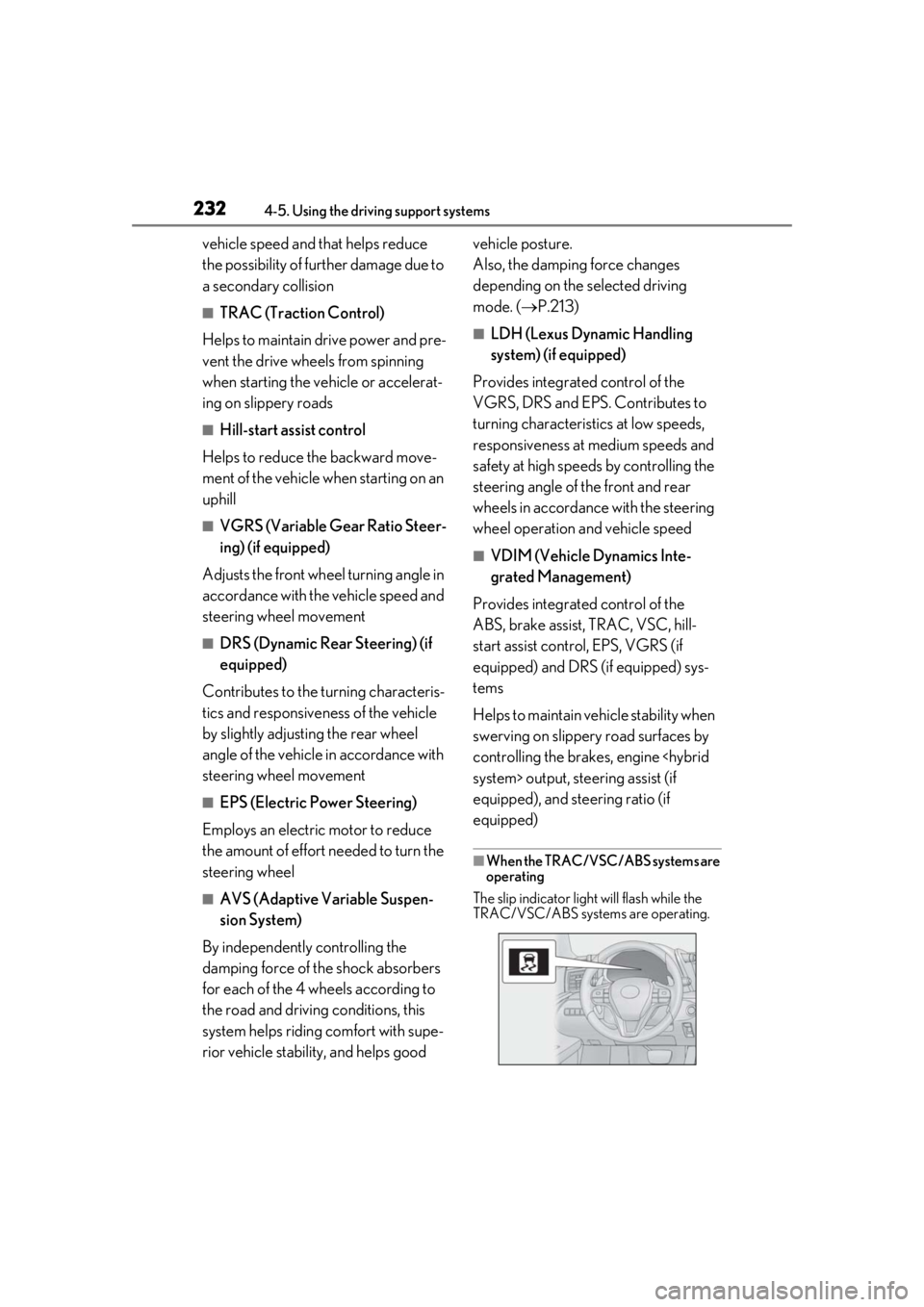
2324-5. Using the driving support systems
vehicle speed and that helps reduce
the possibility of further damage due to
a secondary collision
■TRAC (Traction Control)
Helps to maintain drive power and pre-
vent the drive wheels from spinning
when starting the vehicle or accelerat-
ing on slippery roads
■Hill-start assist control
Helps to reduce the backward move-
ment of the vehicle when starting on an
uphill
■VGRS (Variable Gear Ratio Steer-
ing) (if equipped)
Adjusts the front wheel turning angle in
accordance with the vehicle speed and
steering wheel movement
■DRS (Dynamic Rear Steering) (if
equipped)
Contributes to the turning characteris-
tics and responsiveness of the vehicle
by slightly adjusting the rear wheel
angle of the vehicle in accordance with
steering wheel movement
■EPS (Electric Power Steering)
Employs an electric motor to reduce
the amount of effort needed to turn the
steering wheel
■AVS (Adaptive Variable Suspen-
sion System)
By independently controlling the
damping force of the shock absorbers
for each of the 4 wheels according to
the road and driving conditions, this
system helps riding comfort with supe-
rior vehicle stabilit y, and helps good vehicle posture.
Also, the damping force changes
depending on the selected driving
mode. (
P.213)
■LDH (Lexus Dynamic Handling
system) (if equipped)
Provides integrated control of the
VGRS, DRS and EPS. Contributes to
turning characteristics at low speeds,
responsiveness at medium speeds and
safety at high speeds by controlling the
steering angle of the front and rear
wheels in accordance with the steering
wheel operation and vehicle speed
■VDIM (Vehicle Dynamics Inte-
grated Management)
Provides integrated control of the
ABS, brake assist, TRAC, VSC, hill-
start assist control, EPS, VGRS (if
equipped) and DRS (if equipped) sys-
tems
Helps to maintain vehicle stability when
swerving on slippery road surfaces by
controlling the brakes, engine
equipped), and steering ratio (if
equipped)
■When the TRAC/VSC/ABS systems are
operating
The slip indicator light will flash while the
TRAC/VSC/ABS systems are operating.
Page 235 of 432
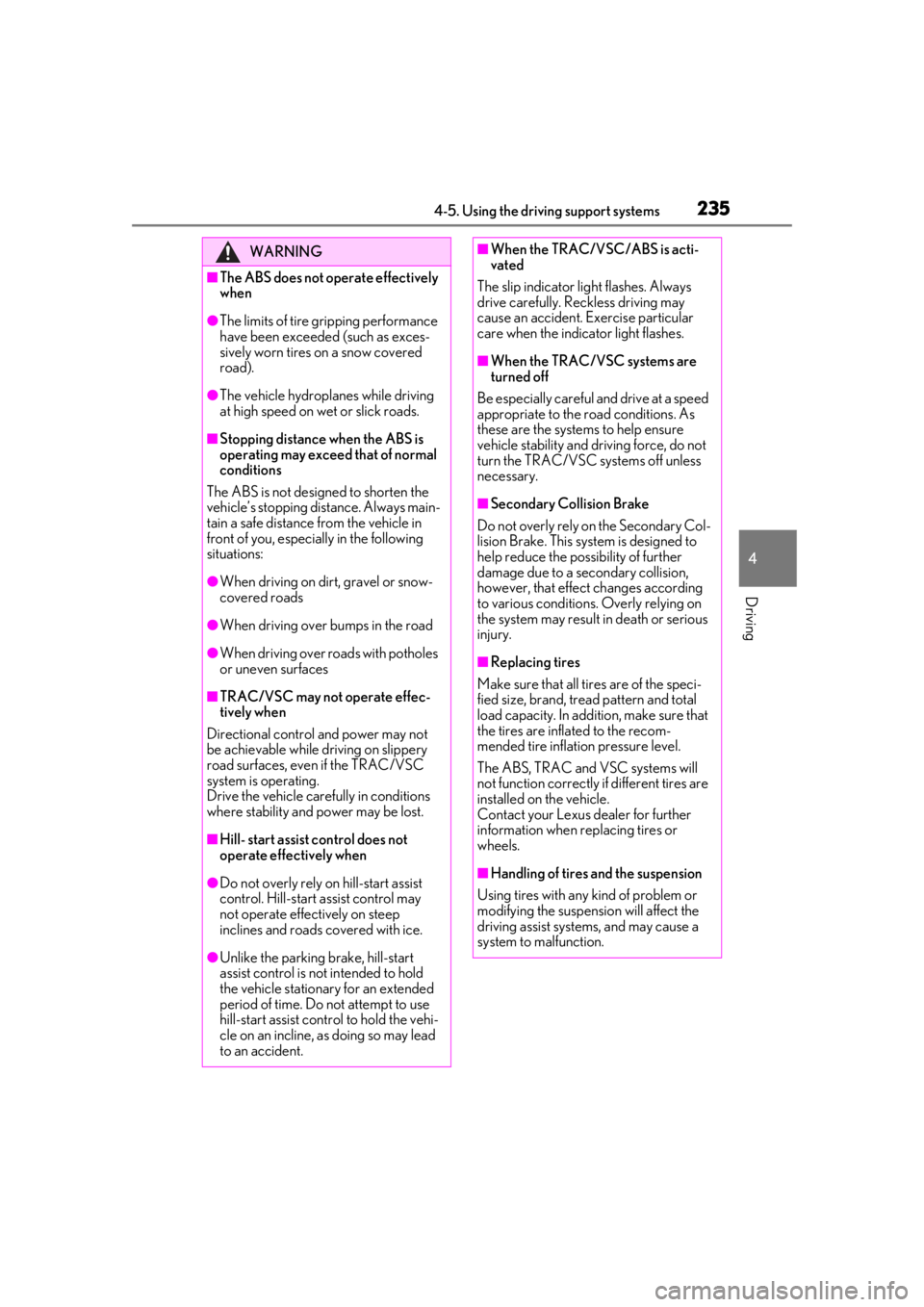
2354-5. Using the driving support systems
4
Driving
WARNING
■The ABS does not operate effectively
when
●The limits of tire gripping performance
have been exceeded (such as exces-
sively worn tires on a snow covered
road).
●The vehicle hydroplanes while driving
at high speed on wet or slick roads.
■Stopping distance when the ABS is
operating may exceed that of normal
conditions
The ABS is not designed to shorten the
vehicle’s stopping di stance. Always main-
tain a safe distance from the vehicle in
front of you, especially in the following
situations:
●When driving on dirt, gravel or snow-
covered roads
●When driving over bumps in the road
●When driving over roads with potholes
or uneven surfaces
■TRAC/VSC may not operate effec-
tively when
Directional control and power may not
be achievable while driving on slippery
road surfaces, even if the TRAC/VSC
system is operating.
Drive the vehicle carefully in conditions
where stability and power may be lost.
■Hill- start assist control does not
operate effectively when
●Do not overly rely on hill-start assist
control. Hill-start assist control may
not operate effectively on steep
inclines and roads covered with ice.
●Unlike the parking brake, hill-start
assist control is not intended to hold
the vehicle stationary for an extended
period of time. Do not attempt to use
hill-start assist control to hold the vehi-
cle on an incline, as doing so may lead
to an accident.
■When the TRAC/VSC/ABS is acti-
vated
The slip indicator light flashes. Always
drive carefully. Reckless driving may
cause an accident. Exercise particular
care when the indicator light flashes.
■When the TRAC/VSC systems are
turned off
Be especially careful and drive at a speed
appropriate to the road conditions. As
these are the systems to help ensure
vehicle stability and driving force, do not
turn the TRAC/VSC systems off unless
necessary.
■Secondary Collision Brake
Do not overly rely on the Secondary Col-
lision Brake. This system is designed to
help reduce the possibility of further
damage due to a secondary collision,
however, that effect changes according
to various conditions. Overly relying on
the system may result in death or serious
injury.
■Replacing tires
Make sure that all ti res are of the speci-
fied size, brand, tread pattern and total
load capacity. In addition, make sure that
the tires are inflated to the recom-
mended tire inflation pressure level.
The ABS, TRAC and VSC systems will
not function correctly if different tires are
installed on the vehicle.
Contact your Lexus dealer for further
information when replacing tires or
wheels.
■Handling of tires and the suspension
Using tires with any kind of problem or
modifying the suspensi on will affect the
driving assist systems, and may cause a
system to malfunction.
Page 236 of 432
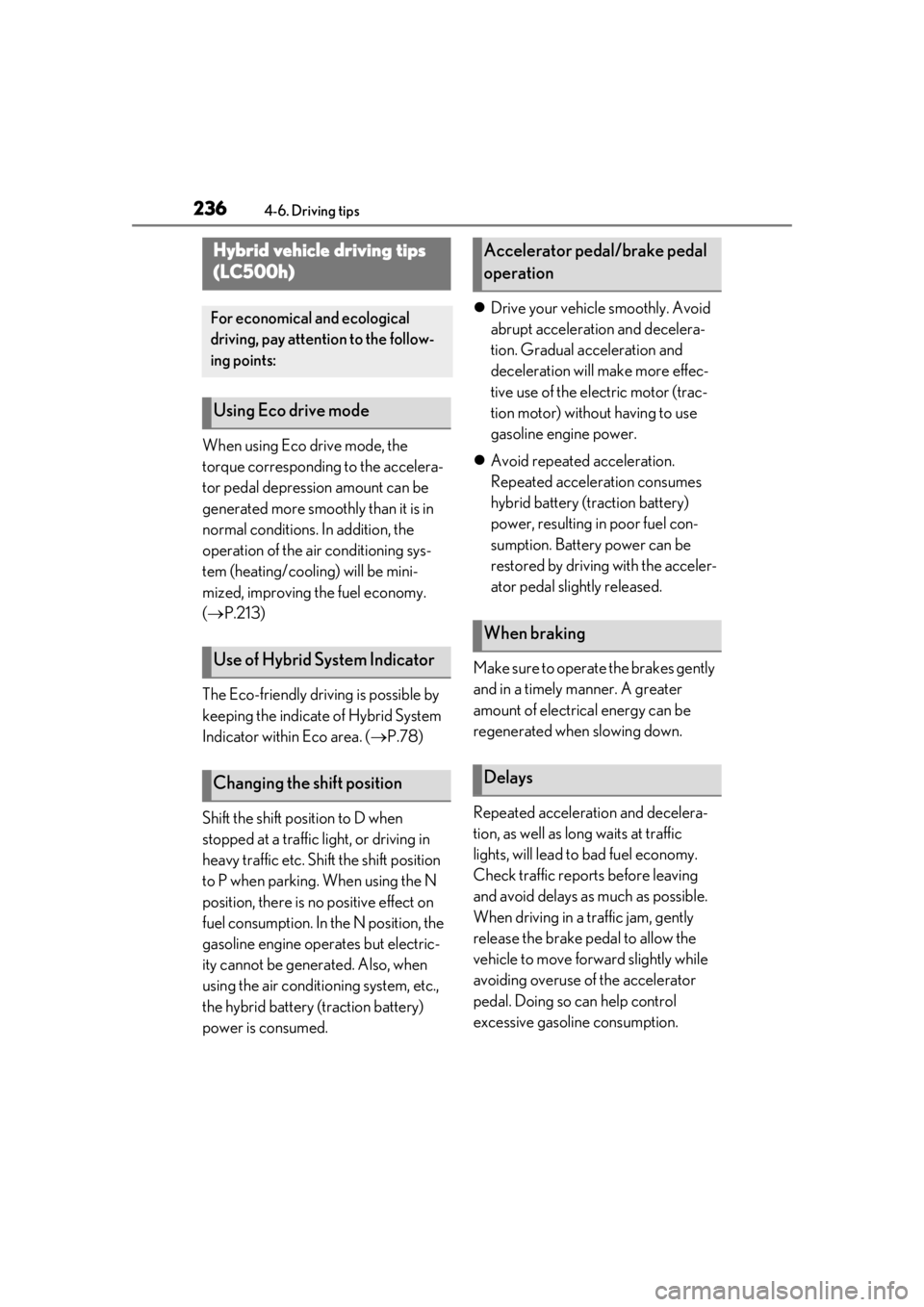
2364-6. Driving tips
4-6.Driving tips
When using Eco drive mode, the
torque corresponding to the accelera-
tor pedal depression amount can be
generated more smoothly than it is in
normal conditions. In addition, the
operation of the air conditioning sys-
tem (heating/cooling) will be mini-
mized, improving the fuel economy.
( P.213)
The Eco-friendly driving is possible by
keeping the indicate of Hybrid System
Indicator within Eco area. ( P.78)
Shift the shift position to D when
stopped at a traffic light, or driving in
heavy traffic etc. Shift the shift position
to P when parking. When using the N
position, there is no positive effect on
fuel consumption. In the N position, the
gasoline engine operates but electric-
ity cannot be generated. Also, when
using the air conditio ning system, etc.,
the hybrid battery (traction battery)
power is consumed.
Drive your vehicle smoothly. Avoid
abrupt acceleration and decelera-
tion. Gradual acceleration and
deceleration will make more effec-
tive use of the electric motor (trac-
tion motor) without having to use
gasoline engine power.
Avoid repeated acceleration.
Repeated acceleration consumes
hybrid battery (traction battery)
power, resulting in poor fuel con-
sumption. Battery power can be
restored by driving with the acceler-
ator pedal slightly released.
Make sure to operate the brakes gently
and in a timely manner. A greater
amount of electrical energy can be
regenerated when slowing down.
Repeated acceleration and decelera-
tion, as well as long waits at traffic
lights, will lead to bad fuel economy.
Check traffic reports before leaving
and avoid delays as much as possible.
When driving in a traffic jam, gently
release the brake pedal to allow the
vehicle to move forward slightly while
avoiding overuse of the accelerator
pedal. Doing so can help control
excessive gasoline consumption.
Hybrid vehicle driving tips
(LC500h)
For economical and ecological
driving, pay attention to the follow-
ing points:
Using Eco drive mode
Use of Hybrid System Indicator
Changing the shift position
Accelerator pedal/brake pedal
operation
When braking
Delays
Page 244 of 432

2445-1. Remote Touch
*1: Refer to the “NAVIGATION SYSTEM OWNER’S MANUAL”.
*2: This function is not made available on some models.
■Split-screen display
Different information can be displayed on the left and right of the screen. For
example, air conditioning system screen can be displayed and operated while the
fuel consumption information screen is be ing displayed. The large screen on the
left of the display is called the main display, and the small screen to the right is
called the side display.
■Main display
For details about the functions and
operation of the main display, refer to
the respective section and “NAVIGA-
TION SYSTEM OWNER’S MAN-
UAL”.■Side display
The following functions can be dis-
played and operated on the side dis-
play.
Select or to display the desired
screen.
When an Apple CarPlay con-
nection is established and this
button displays “Apple Car-
Play”, select to display the home
screen of Apple CarPlay.
*1, 2
Select to display the information
screen.
*1 ( P.96, 98)
Select to disp lay the “Setup”
screen.
*1
Select to display the air condi-
tioning control screen. ( P.251)
SwitchFunction